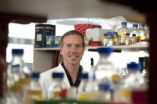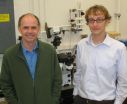(Press-News.org) Scientists have identified a single mutated gene that causes Hajdu-Cheney syndrome, a disorder of the bones causing progressive bone loss and osteoporosis (fragile bones). The study, published in Nature Genetics today, gives vital insight into possible causes of osteoporosis and highlights the gene as a potential target for treating the condition.
There are only 50 reported cases of Hajdu-Cheney syndrome (HCS), of which severe osteoporosis is a main feature. Osteoporosis is a condition leading to reduction in bone strength and susceptibility to fractures. It is the most common bone disease, with one in two women and one in five men over 50 in the UK fracturing a bone because of the condition. This represents a major public health problem yet, until this study, possible genetic causes of osteoporosis were poorly understood.
The team of scientists, led by the National Institute for Health Research (NIHR) comprehensive Biomedical Research Centre (BRC) at King's College London and Guy's and St Thomas', set out to investigate the genetic cause of HCS in order to detect clues to the role genes might play in triggering osteoporosis.
Using a cutting edge technique for identifying disease-causing genes, known as exome sequencing, the team were able to identify NOTCH2 as the causative gene using DNA from just three unrelated HCS patients. The team then confirmed their findings in an additional 12 affected families, 11 of whom had an alteration in the identical portion of the same gene.
Professor Richard Trembath, Head of King's College London's Division of Genetics and Molecular Medicine and Medicine Director of the NIHR BRC, said: "Up until now, we knew very little about the genetic mechanisms of severe bone disease. But these findings add to our understanding of the uncommon condition of HCS and provide an important basis to develop future studies in more common forms of osteoporosis, including the development of potential new therapies."
INFORMATION:
Notes to editors:
For further information please contact Emma Reynolds, Press Officer, King's College London, on 0207 848 4334 or email emma.reynolds@kcl.ac.uk.
A copy of the Nature Genetics paper is available on request.
The study was part-funded by the British Heart Foundation, and Cure Kids New Zealand.
1. The comprehensive Biomedical Research Centre at Guy's and St Thomas' NHS Foundation Trust and King's College London, is one of five National Institute for Health Research (NIHR) comprehensive Biomedical Research Centres in England. With its strong focus on 'translational research' across seven research themes and a number of cross-cutting disciplines, it aims to take advances in basic medical research out of the laboratory and into the clinical setting to benefit patients at the earliest opportunity. Access to the uniquely diverse patient population of London and the south east enables it to drive forward research into a wide range of diseases and medical conditions.
Website: www.biomedicalresearchcentre.org
2. Guy's and St Thomas' provides around 900,000 patient contacts in acute and specialist hospital services every year. As one of the biggest NHS Trusts in the UK, it employs almost 11,000 staff. The Trust works in partnership with the Schools of Medicine, Dentistry, Nursing and Biomedical Sciences of King's College London and other Higher Education Institutes to deliver high quality education and research. Website: www.guysandstthomas.nhs.uk.
3. King's College London is one of the top 25 universities in the world (2010 QS international world rankings), The Sunday Times 'University of the Year 2010/11' and the fourth oldest in England. A research-led university based in the heart of London, King's has nearly 23,000 students (of whom more than 8,600 are graduate students) from nearly 140 countries, and some 5,500 employees. King's is in the second phase of a £1 billion redevelopment programme which is transforming its estate.
4. Guy's and St Thomas' is part of King's Health Partners Academic Health Sciences Centre (AHSC), a pioneering collaboration between King's College London, and Guy's and St Thomas', King's College Hospital and South London and Maudsley NHS Foundation Trusts. King's Health Partners is one of only five AHSCs in the UK and brings together an unrivalled range and depth of clinical and research expertise, spanning both physical and mental health. Our combined strengths will drive improvements in care for patients, allowing them to benefit from breakthroughs in medical science and receive leading edge treatment at the earliest possible opportunity.
For more information, visit www.kingshealthpartners.org
5. The National Institute for Health Research (NIHR) provides the framework through which the research staff and research infrastructure of the NHS in England is positioned, maintained and managed as a national research facility. The NIHR provides the NHS with the support and infrastructure it needs to conduct first-class research funded by the Government and its partners alongside high-quality patient care, education and training. Its aim is to support outstanding individuals (both leaders and collaborators), working in world-class facilities (both NHS and university), conducting leading-edge research focused on the needs of patients. www.nihr.ac.uk
END
Clinical research has greater societal impact over a 15-20 year timescale, while basic research has greater academic impact, according to a new study from RAND Europe and the Health Economics Research Group (HERG) at Brunel University.
Project Retrosight was a multinational, four-year study that investigated the translation of basic biomedical and clinical cardiovascular and stroke research, and its impact on future work, policy, products and healthcare. The study was based on a rich source of material taken from 29 carefully selected case studies of grants for research ...
OTTAWA – March 6, 2011 – Insight into the complex biological mechanisms that cause heart disease has taken a major step forward with the discovery of 13 new genes that increase the risk of coronary artery disease (CAD). The influence of the majority of the new genes is independent of other established risk factors, suggesting new, unsuspected causes of CAD. The discovery more than doubles the number of genes known to affect the progression of heart disease.
The research also verified the association of 10 previously identified genes to the population at large, meaning ...
Scientists from the Walter and Eliza Hall Institute have identified the key immune cell population responsible for regulating the body's immune response.
The finding could have wide-ranging repercussions for the treatment of autoimmune diseases, organ transplantation and cancer, and change how the efficacy of newly developed drugs is measured.
The discovery was made by Dr Erika Cretney, Dr Axel Kallies and Dr Stephen Nutt from the institute's Molecular Immunology division. It centred on a population of immune cells called regulatory T cells.
Regulatory T cells (T-regs) ...
Japanese researchers have been immersing iron-based compounds in hot alcoholic beverages such as red wine, sake and shochu to induce superconductivity.
Scientists from the National Institute for Materials Science, Japan, found that immersing pellets of an iron-based compound in heated alcoholic beverages for 24 hours greatly increase their superconducting ability.
Iron-based compounds usually become superconductive after being exposed to air. This process however can take up to several months. This study demonstrated that superconductivity can be induced in just one ...
Microbicides can be used to protect against HIV, and other sexually transmitted diseases, either on their own or with the added protection of a condom. New research published by BioMed Central's open access journal AIDS Research and Therapy has investigated the use of lubricants, originally designed for vaginal application, and has developed and tested new, rectal specific, formulations.
Unprotected sex is one of the major ways that HIV spreads through the population. However most research has focused on the production of vaginal microbicides which, due to differences ...
An international research collaboration has identified 13 new gene sites associated with the risk of coronary artery disease and validated 10 sites found in previous studies. Several of the novel sites discovered in the study, which is being published online in Nature Genetics, do not appear to relate to known risk factors, suggesting previously unsuspected mechanisms for cardiovascular disease.
"We now have identifed 23 specific genetic 'letters' that appear to confer risk for myocardial infarction and other aspects of coronary artery disease," says Sekar Kathiresan, ...
In an improvement over open-heart surgery, cardiologists now use catheters to eliminate damaged heart tissue in certain patients, such as those with arrhythmias. But this, too, can be a long and painful procedure as many catheters, with different functions, need to be inserted sequentially.
Now an interdisciplinary team including researchers from Northwestern University has developed one catheter that can do it all. This tool for cardiac ablation therapy has all necessary medical devices printed on a standard balloon catheter: a device for eliminating damaged tissue using ...
LA JOLLA, CA – "Pluripotent" stem cells—which have the potential to mature into almost any cell in the body—are being widely studied for their role in treating a vast array of human diseases and for generating cells and tissues for transplantation. Now, a team of Scripps Research Institute scientists has created a quality control diagnostic test that will make it much easier for researchers to determine whether their cell lines are normal pluripotent cells.
The study was published in an online version of Nature Methods on March 6, 2011.
"Many scientists are unhappy ...
(Santa Barbara, Calif.) –– Precision measurement in the world of nanoparticles has now become a possibility, thanks to scientists at UC Santa Barbara.
The UCSB research team has developed a new instrument capable of detecting individual nanoparticles with diameters as small as a few tens of nanometers. The study will be published on line this week by Nature Nanotechnology, and appear in the April print issue of the journal.
"This device opens up a wide range of potential applications in nanoparticle analysis," said Jean-Luc Fraikin, the lead author on the study. ...
About two-thirds of baby boomers (67%) and generation X'ers (63%) and half of generation Z'ers (50%) and generation Y'ers (49%) watch television every night or almost every night within the hour before going to sleep.
"Artificial light exposure between dusk and the time we go to bed at night suppresses release of the sleep-promoting hormone melatonin, enhances alertness and shifts circadian rhythms to a later hour—making it more difficult to fall asleep," says Charles Czeisler, PhD, MD, Harvard Medical School and Brigham and Women's Hospital. "This study reveals that ...

